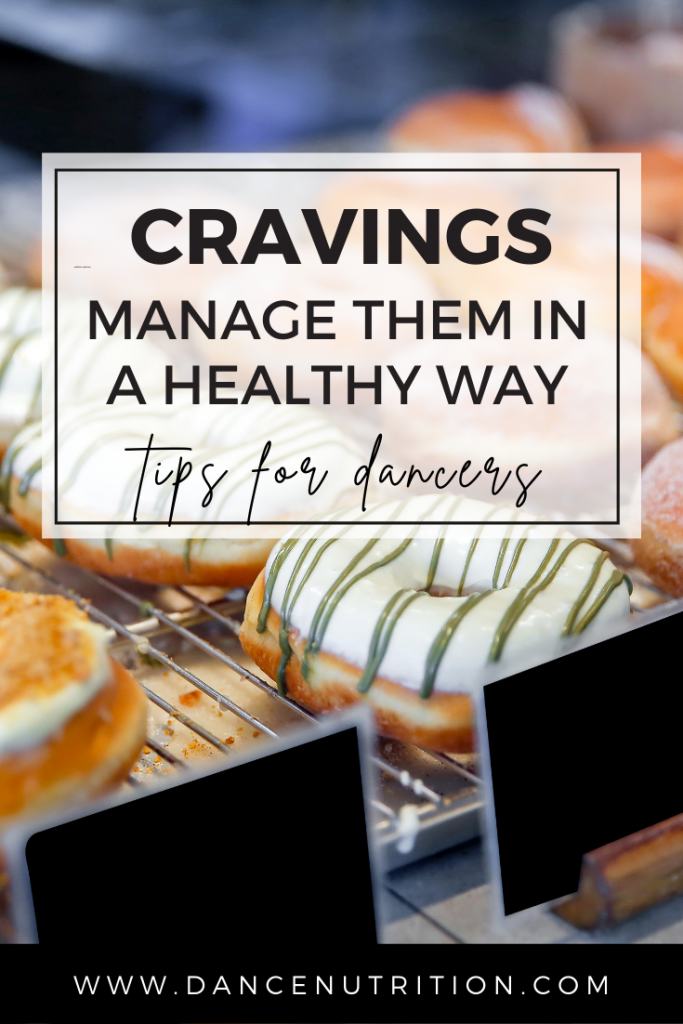When dancers think about cravings, it’s often through a lens of guilt and fear, especially when those cravings involve foods like cookies, fries, or donuts. Unfortunately, this perception is rooted in dancer diet culture and a misunderstanding of what intuitive eating really is.
Let’s set the record straight: healing your relationship with food isn’t about abandoning nourishment in favor of “indulgent” foods. It’s about honoring your body’s cues, including cravings, in a way that supports your physical health, emotional well-being, and dance performance. As a multi-certified Registered Dietitian Nutritionist, I help dancers do exactly that.
In this article, we’ll unpack:
- Why dancers experience cravings
- What those cravings mean
- How to manage them without falling into the all-or-nothing mindset that so often derails progress
Why Do Dancers Experience Cravings?
Cravings are a completely normal, biologically driven response. They’re often a sign that your body is trying to communicate something important. Three common reasons dancers experience cravings include:
- Restrictive Eating. Whether it’s intentional dieting or subtle food rules (like avoiding carbs or eating “clean”), a surge in hunger-specific hormones like ghrelin and neuropeptide-Y increases cravings for foods higher in fat and carbs, respectively.
- Lack of Sleep. Inadequate sleep elevates hunger hormones like ghrelin and reduces levels of leptin, which regulates satiety. The result? Intensified cravings for quick-energy foods, particularly carbs. Unfortunately, dancers’ packed schedules often mean compromised rest.
- Hormonal Shifts (Menstruation). Cravings during the menstrual cycle are common and driven by fluctuations in estrogen and progesterone, both of which influence appetite and mood.
Cravings are often seen as a weakness in dance culture, but they’re one of the most direct ways your body asks for support. The key is learning to listen (without shame) and respond with curiosity and care.
What Are Cravings Trying to Tell You?
The experience of cravings can vary depending on where you are in your journey with food. Let’s break it down:
Scenario 1: You’re new to Intuitive Eating and tired of the binge-restrict cycle. You’re ready to heal your relationship with food, but deep down, you still hope to change your weight or shape.
Cravings in this stage are often intense because your body is still trying to compensate for chronic restriction. You might be under-eating without realizing it, or following rigid “healthy” food rules that deprive your body of key macronutrients. Cravings here are a red flag: your body needs nourishment.
Scenario 2: You understand the basics, but food rules still linger. Maybe you’ve worked with a nutritionist, built a fueling plan, and started releasing food guilt. But you’re still experiencing moments of “over”-eating (or eating past fullness).
In this phase, cravings are likely tied to lingering food fears. Remember, it’s human nature to want what we believe we “can’t” or “shouldn’t” have. The more forbidden a food feels, the more power it holds. Removing that moral value helps neutralize the craving.
So… How Should Dancers Respond to Cravings?
First things first: you must eat enough, having consistent meals and snacks throughout the day. Cravings often spike when your body isn’t getting adequate energy or key nutrients. Prioritize balanced meals and snacks that include all three macronutrients, especially carbohydrates and fats, which are frequently restricted by dancers yet are essential for energy and satisfaction.
Here are two helpful deep-dives:
It’s always important to honor cravings, but let’s break down how to do this without feeling vulnerable to that all-or-nothing mindset.
Craving Management ≠ Craving Elimination
The goal isn’t to “get rid of” cravings. It’s to understand them, respond to them, and create an eating pattern that makes you feel energized, not deprived. Try this:
- Get curious, not critical. Ask yourself: What might my body be asking for right now?
- Honor satisfaction. Permitting yourself to eat foods you love reduces their emotional charge over time. This is where tools like food neutrality, flexibility, and unconditional permission come into play.
- Reflect on how food makes you feel. Are there meals that left you sluggish or physically unwell? Energized? Bloated? Comforted? Use that information to guide (not police) your future choices.
Over time, you may notice your cravings diversify. What once felt like constant urges for sweets or chips may evolve into cravings for roasted veggies, grilled salmon, or hearty grains. That’s the beauty of rebuilding trust with your body.
“Help! My Cravings Feel Like a Downfall”
If cravings still feel overwhelming, pause and ask yourself:
- Am I using food to change my weight, shape, or size?
- Am I using food to support my performance?
- Am I using food to support my mental, emotional, and physical well-being?
Now, aim to shift your mindset toward questions 2 and 3. For example:
- Are you eating to enhance stamina in class?
- To support your digestive system?
- To promote mental clarity, or reduce injury risk?
These are all valid and empowering reasons to eat. But if your primary motivation is weight control, it’s likely that cravings (and food guilt) will persist.
This is where body image work becomes essential alongside your work in rebuilding your relationship with food.
In The Healthy Dancer® Framework, These Goals Can Coexist
Many dancers want to choose foods that feel good and let go of the guilt tied to “eating wrong.” The truth? These goals aren’t opposites— they’re partners. Caring about your food choices is great, but micromanaging them can lead to unsustainable behaviors. The Healthy Dancer® teaches you to:
- Dismantle external diet rules
- Reconnect to internal cues of hunger, fullness, and satisfaction
- Heal food fears
- Apply gentle nutrition and performance fueling without sacrificing joy in eating
This process makes up the fourth and fifth values of The Healthy Dancer® Framework. If you’re ready to dive deeper, I offer a full course dedicated to this journey.
Because when you understand your cravings (and honor them), you unlock the ability to nourish your body without fear.



